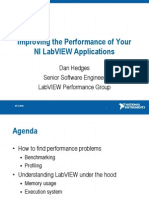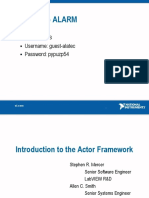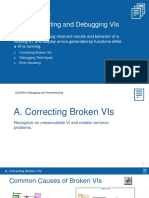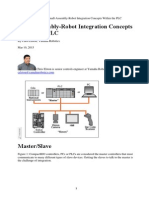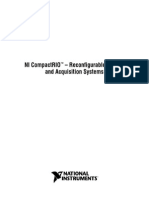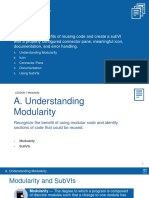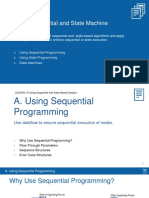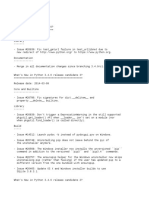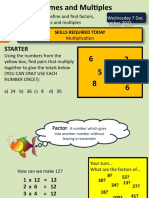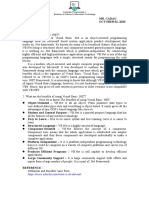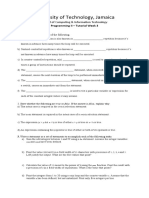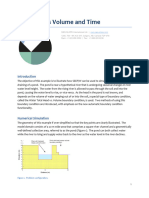Lesson 2 Creating Your
First Application
Use Express VIs to produce a project and simple VI that
acquires and analyzes data and then displays the results.
A. Dataflow
B. LabVIEW Data Types
C. Tools for Programming, Cleaning and Organizing Your VI
D. Building a Basic VI
1
LESSON 2 Creating Your First Application
A. Dataflow
Recognize characteristics of dataflow on the block diagram.
2
A. Dataflow
Key Points of Dataflow
Node executes only when all input data
are available.
Node supplies data to the output
terminals only when it is finished
executing.
3
LESSON 2 Creating Your First Application
Activity 2-1
Exploring Dataflow
Identify dataflow execution order in the following block diagrams.
4
A. Dataflow
Dataflow: Example A
5
A. Dataflow
Dataflow: Example B
?
6
A. Dataflow
Dataflow: Example C
7
A. Dataflow
Dataflow: Example D
8
LESSON 2 Creating Your First Application
B. LabVIEW Data Types
Recognize the different data types and how they relate to
front panel objects.
• Accessing Object Properties • Strings
• Boolean Data • Enums
• Numeric Data Representations • Other Data Types
9
B. LabVIEW Data Types
Terminals and LabVIEW Data Types
Terminals visually convey information about data type.
10
LESSON 2 Creating Your First Application
Demonstration
Accessing Object Properties
11
B. LabVIEW Data Types
Boolean Data
12
LESSON 2 Creating Your First Application
Multimedia Module
Mechanical Actions of Boolean Controls
13
LESSON 2 Creating Your First Application
Multimedia Module
Numeric Data Representations
14
B. LabVIEW Data Types
Strings
15
LESSON 2 Creating Your First Application
Demonstration
Enums
16
B. LabVIEW Data Types
Other Data Types
Type Terminal Description
Dynamic Stores the information generated or acquired
by an Express VI
Path Stores the location of a file or directory
Waveform Carries the data, start time, and dt of a
waveform
17
LESSON 2 Creating Your First Application
C. Tools for Programming,
Cleaning, and Organizing Your VI
Recognize tools for making clean, readable front panels and
block diagrams, and for documenting VIs.
• Programming Tools
• Wiring Tips
• Making Code Readable
18
LESSON 2 Creating Your First Application
Demonstration
Programming Tools
Automatic tool selection
Tools Palette
19
LESSON 2 Creating Your First Application
Demonstration
Wiring Tips
20
LESSON 2 Creating Your First Application
Exercise 2-1
Selecting a Tool
Become familiar with automatic tool selection and the Tools palette in
LabVIEW.
21
LESSON 2 Creating Your First Application
Exercise 2-1
Selecting a Tool
How do you enable automatic tool selection?
22
LESSON 2 Creating Your First Application
Demonstration
Making Code Readable
23
LESSON 2 Creating Your First Application
D. Building a Basic VI
Recognize Express VIs and be able to apply them appropriately.
24
D. Building a Basic VI
Building a Basic VI
25
LESSON 2 Creating Your First Application
Activity 2-2
Program Architecture for Simple AAV VI
Refer to the participant guide to answer questions about the program
architecture of a simple AAV VI and then discuss the answers as a group.
26
LESSON 2 Creating Your First Application
Exercise 2-2
Simple Acquire, Analyze, and
Visualize VI
Create a simple VI that acquires data, analyzes data, and displays the
results.
27
LESSON 2 Creating Your First Application
Exercise 2-2
Simple Acquire, Analyze, and
Visualize VI
How do you determine the file path of the generated text file?
28
LESSON 2 Creating Your First Application
Activity 2-3
Lesson Review
Refer to the participant guide to answer questions about what you have learned
in this lesson and then discuss the answers as a group.
29
Lesson Review
1. Which function executes first: Add or
Subtract?
a. Add
b. Subtract
c. Unknown
30
Lesson Review
1. Which function executes first: Add or
Subtract?
a. Add
b. Subtract
c. Unknown
31
Lesson Review
2. Which function executes first: Sine or
Divide?
a. Sine
b. Divide
c. Unknown
32
Lesson Review
2. Which function executes first: Sine or
Divide?
a. Sine
b. Divide
c. Unknown
33
Lesson Review
3. Which of the following functions executes
first: Random Number, Add or Divide?
a. Random Number
b. Divide
c. Add
d. Unknown
34
Lesson Review
3. Which of the following functions executes
first: Random Number, Add or Divide?
a. Random Number
b. Divide
c. Add
d. Unknown
35
Lesson Review
4. Which of the following
functions executes last: Random Number,
Subtract or Add?
a. Random Number
b. Subtract
c. Add
d. Unknown
36
Lesson Review
4. Which of the following
functions executes last: Random Number,
Subtract or Add?
a. Random Number
b. Subtract
c. Add
d. Unknown
37
Lesson Review
5. If an input to a function is marked with a
red dot (known as a coercion dot), what
does the dot indicate?
a. Data was transferred into a structure.
b. That input has not been wired
c. The wire is broken
d. The value passed into a node was converted to a different
representation.
38
Lesson Review
5. If an input to a function is marked with a
red dot (known as a coercion dot), what
does the dot indicate?
a. Data was transferred into a structure.
b. That input has not been wired
c. The wire is broken
d. The value passed into a node was converted to a
different representation.
39
Lesson Review
6. Which mechanical action causes a Boolean control in the
FALSE state to change to TRUE when you click it and
stay TRUE until LabVIEW has read the value?
a. Switch Until Released
b. Switch When Released
c. Latch When Pressed
d. Latch When Released
40
Lesson Review
6. Which mechanical action causes a Boolean control in the
FALSE state to change to TRUE when you click it and
stay TRUE until LabVIEW has read the value?
a. Switch Until Released
b. Switch When Released
c. Latch When Pressed
d. Latch When Released
41





